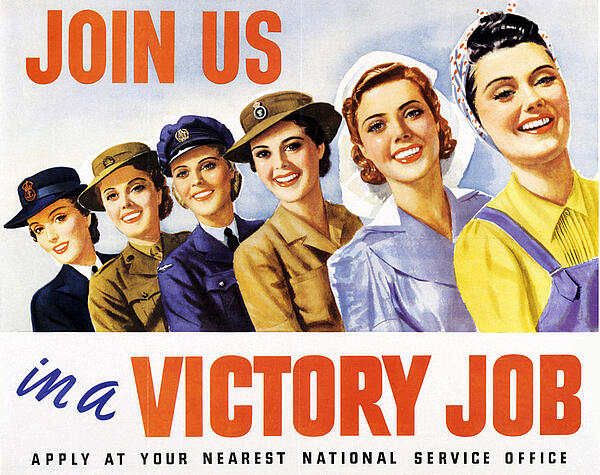Women in World War Two
Women in World War Two took on a wide variety of roles to help in the war effort. They worked in munition factories, served in the Auxiliary Territorial Service and took on agricultural work as part of the Land Army. However, when the war ended these advances were greatly reduced.
Like in World War One, women were able to take up employment that was inaccessible to them before World War Two. Below is a selection of some of the jobs carried out by women in wartime.

The Women's Land Army:
In World War Two women were once again called on to support agricultural work. The Women’s Land Army was reformed in July 1939.
At the beginning of the war recruitment was slow ans only 7,000 women were signed up in August 1940. However, the U-Boat crisis sent fears over food soaring and women joined the WLA in droves.
The government attempted to present the WLA’s work as glamorous though its adverts. In reality, the work was far from glamorous - the women had to work long hours for low pay, often in isolated villages. Work was especially tough in winter when women had to prepare the ground for sowing - a laborious task. However, the women generally ate well and enjoyed their experience in the WLA.
Factory Work:
Many women took up work in factories to replace lost manpower during the war. Women entered a number of industries, including the munitions and uniform production.
Skilled women could earn £2.15 a week. This was a substantial wage, but men were still paid more for doing the same work. In 1943, women at the Rolls Royce factory in Glasgow went on strike over the issue. However, this was seen as highly unpatriotic and the strikes were pelted with food.
However, when the protestors discovered how much the women in the Land Army were being paid - 32 shilling a week - they put an end to the protest.
The Women's Voluntary Service (WVS):
The WVS played a key part in the evacuation of civilians from urban areas during World War Two. It is credited with helping to move 1.5 million people (the majority were children) out of cities in the early days of September 1939. The WVS had one million members by 1943, most of whom were elderly women desperate to help with the war effort.
The Auxiliary Territorial Service:
The Auxiliary Territorial Service (ATS) was the women’s branch of the Territorial Army during the Second World War. Formed on 9 September 1938, the ATS had 65,000 members by 1941.
Recruits would be sent to army camps where they would receive basic training and at the end of four weeks of training they would be given a role within the ATS. Notable members included Queen Elizabeth II and Mary Churchill, Winston Churchill’s youngest daughter.
The Women's Auxiliary Air Force:
The Women’s Auxiliary Air Force (WAAF) was formed in June 1939 when war seemed imminent. In its early years the members of the WAAF filled posts as drivers or kitchen orderlies, but as the war progress roles diversified. By the end of the war, members were involved in the interception of codes and cyphers, the interpretation of aerial photographs, the operation of balloon sites and many other important wartime jobs.
Secret Agents:
Somen women worked as secret agents during World War Two. These women were members of SOE (Special Operations Executive) and, after receiving intense training, were parachuted into occupied France. As they were working behind enemy lines there work was very dangerous. They did a hugely important job in protecting national security by finding out all the information they could from the enemy. However, they risk capture, torture and death. Violette Szabo and Odette Churchill were among the most famous SOE agents and both received the George Cross. Violette Szabo was murdered by the Gestapo while Odette Churchill survived the war.
By the end of the war, there were more than 6.5 million in civilian war work and 460,000 women in the military. Women played a major role during World War Two and the attitudes to the role of women in the services and work were changed forever. After the war the WRNS became a permanent service and in 1993 were assimilated into the main body of the Navy. In 1949 the ATS was replaced by the Women's Royal Army Corps, which remained until 1992. The Women's Auxiliary Air Force was renamed to the Women's Royal Air Force in 1949 and merged with the RAF in 1994. The ATA were disbanded after the war and FANY, the oldest women’s service organisation, are still in existence today.
See also:
How to be a Good Wife
MLA Citation/Reference
"Women in World War Two". HistoryLearning.com. 2024. Web.
